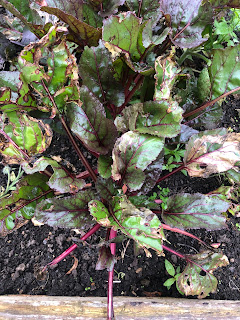As anyone with an allotment or fruit trees in the U.K. will know, this has been a Mast Year for trees producing nuts and fruit - meaning an absolute glut of produce. The weather conditions conspired to make everything go into overdrive and as a result boughs are bent under the weight of apples, plums, pears, everything. I had to take off half the unripe plums to stop the victoria plum's branches snapping under their weight. People literally cannot give away their apples for free because everyone has far more than they can use.
There is one exception in our garden - my beautiful little quince tree in a pot. We had a wind storm just after the blossom opened and they blew off without a chance to be pollinated, so it's another year without fruit for me. But not, it seems, for others.
 |
| Somewhat overripe but scented quinces |
I was lucky enough to get a bag of quince from a guy with heavily cropping tree in our old neighbourhood. They are like large yellow pears with an amazing smell and a dense texture. I kept sticking my head in the bag to sniff them because it was just so delightful. It's a hard scent to describe, but it's fruity and perfumed at the same time, and nothing else is quite like it.
I had made quince jam before but I wasn't happy with the slightly gritty texture. You know that underripe pear sensation, where it's a bit granular? It's like that writ large. I had clearly not done something right, but all the blogs and articles I read about quince said either that you needed to push it through a mouli, that it just was slightly grainy, or that if it's grainy you're doing it wrong but without any further information of how to do it right. So I decided to make quince jelly instead - like the membrillo you can buy in Spain to have with manchego and other hard cheeses, but not quite as tart. Let's be honest, any excuse to eat cheese is a win.
I roughly chopped the fruit - which took some doing, those things are rock hard! Between the pesto making and the quince my arms are going to be bulging with muscles at this rate. (One can dream). I put it in a large pan with some water and simmered it until mushy - it took about 2 hours. One of the nice things about making a jelly rather than a jam is you don't have to peel and core anything, just whack it into chunks and let it cook down slowly, so it's a nice easy way to make a preserve.
 |
| Rather enthusiastically bubbling quince |
As an aside, I hope everyone has a Cliff's in their life. The sort of place where you can hold up the broken bit of dishwasher or esoteric connecting pipe and they'll reach behind their counter and say "like one of these?" and you will be able to fix whatever it is, even if you do have to go back twice more for further advice. It's a bit like a halfway house between Mr Hooper's store and Luis's fix it shop on Sesame Street - they don't do the repair but they sell you the stuff so you can, and explain what you need to do if you're unsure. The staff are unbelievably patient, friendly and knowledgeable. Timber, plumbing, tea cosies, bird seed, bedding plants, hay for your guinea pigs - Cliff's Hardware has you covered.
With this rare lapse by Cliff's, I still had not straining bag. Mark offered a trip to Harrogate to buy one from Lakeland, which would have included a bonus trip to Betty's for a fondant fancy (my personal favourite) but as he was in the midst of painting the kitchen I declined. Better to get that done than my domestic experimenting. I had found a metre of muslin in my search, though, so I ran up a spectacularly bad but still functional drawstring bag on the sewing machine. I really should remember the bit about measuring twice before I cut once. Oops.
 |
| We're in the middle of decorating, of course it's a mess |
The result as a scant pint of juice, give or take. I added 400g of sugar to the liquid and simmered it to reduce until it reached 104.5 degrees Celsius. That left me with a single jam jar of crystal clear pink jelly - not much to show for 2 kg, 2 hours cooking, 18 hours draining and then half an hour simmering with sugar, is it?
But throughout that time the house smelled amazing. And to be honest I wasn't making quince jelly because we needed a decent supply of it, I was doing it because it seemed like fun.
I should have stopped a little before 104.5 as the quince jelly is very firm. Then again, the Owl and the Pussycat dined on slices of quince, so it's probably meant to be like that. At least, that's what I'm now claiming.
So there we have it - one glowing jar of scented beauty, to be put aside until the Christmas cheeseboard brings cheeses worth such an effort.
The owl and the pussycat went to sea
In a beautiful pea-geen boat...
...They dined on mince, and slices of quince,
Which they ate with a runcible spoon

























